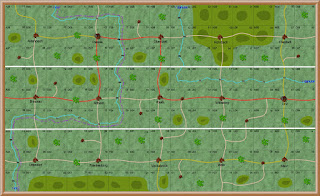Proposed campaign areas
The current Linz PBEM campaign is still going strong, and
probably has a few more battles in it.
On the other hand it could end unexpectedly. In either case it is time to start work on
the next campaign.
I am still uncertain whether to run another phase of the
current 1813 campaign, or to start a new campaign completely different from the
current one.
First I started work on another phase of the current
one. It will be based in Northern
Germany and will be based on Hamburg.
It will probably be a four player game, rather than the current six players. This is because I want more space for each
player, and less need to restrict their choice of movement.
Then I started thinking about a whole new campaign concept. This would start with a blank page, and is a
much more exciting prospect. I have
already got a good idea of what I would like to do.
When I started my current 1813 campaign it was a solo
campaign. I wanted to use all of my
model soldiers, so I had five campaign areas.
Each would have a French army and one of my five allied armies. Each army would be four corps. As a solo campaign I could manipulate the
campaign to produce battles/wargames as and when I wanted them.
The change to PBEM required a lot of changes, in particular
smaller armies for each player. Instead
of being a campaign based on two armies of four corps each, it became a
campaign of four corps commanders with one corps each. It worked ok, but it resulted in much smaller
battles/wargames than I had planned for.
If I change I will run the whole five campaign areas at the
same time. There will be ten command
vacancies. Each will be a commander in
chief with four corps. Each area will
have just two players, one French and one allied. They will have an area similar to the
current tactical map. But with only one
player per side they will have much more freedom of choice.
There will be an objective (a town) in each campaign
area. When the objective is taken that
will be the end of that particular phase of the campaign. The other four areas will carry on, but the
two players in that area will have finished their command role. They could then either carry on with the next
objective, or I could find a replacement player. So the commitment will be about three or
four months, the same as it is now.
The great advantage of the proposed campaign is that I will
not have to keep a team of six players going for three or four months. Instead it will be five teams of two players
each. It will mean that I will need to
find constant replacement players, but the loss of one will only affect their
particular phase. And if necessary I can
take over that role until I find a replacement.
As always it seems great in theory. But I have found that the actual practice is
always a lot different. I hesitate to
abandon a campaign concept which has run for three years and has worked well. On the other hand I would enjoy the
challenge of a new campaign concept.
I will ask for comments on the campaign forum and see if
there is any preference one way or the other.



